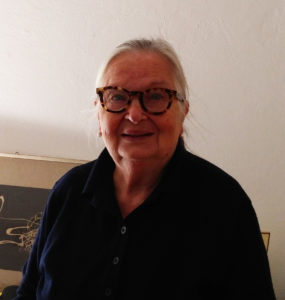 Even at the age of 89 years, Greta Schödl still continues to create. Her range of techniques is very large; however, scripture and gold are particularly prominent in her work. We met in her apartment in Bologna, where we spoke about her background, artistic career and oeuvre.
Even at the age of 89 years, Greta Schödl still continues to create. Her range of techniques is very large; however, scripture and gold are particularly prominent in her work. We met in her apartment in Bologna, where we spoke about her background, artistic career and oeuvre.
Astrid Gallinat: Your father was veterinarian and your mother housewife. How did you get in touch with the arts?
Greta Schödl: Besides his work, my father was drawing. My mother was also very creative with her hands. Since my childhood, me too, I worked with all the materials that I found. I made sculptures of wood, drawings. We worked all the time somehow creative.
A.G.: You studied at the Academy of Applied Art in Vienna. Why have you chosen the applied art and not the fine arts?
G.S.: First of all, my father was not very happy that I wanted to go in the direction of arts. I was the only child and he hoped for a more reliable profession. Moreover, I have chosen the applied arts, because of its wider spectrum. Nonetheless, I frequented also the fine arts. I was interested in the restoration, foundry, the masters etc. Therefore, I was always in the studios of the applied or of the fine arts to acquire many interesting things. I had not yet a clear idea what I wanted to do, but I wanted to learn as much as possible.
A.G.: Which specialisation have you taken?
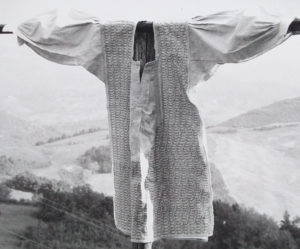 G.S.: Industrial textile printing: carpets, fabric. First, I wanted to do goldsmithing, but there was no place. So I went to the textile printing. As the academy was very open, it was possible to go from one place to the other in the afternoon. I lived in there the whole day, I frequented a bit of all disciplines, and I went where it was interesting for me. Afterwards I experimented with the different techniques even from other disciplines and applied this on textiles.
G.S.: Industrial textile printing: carpets, fabric. First, I wanted to do goldsmithing, but there was no place. So I went to the textile printing. As the academy was very open, it was possible to go from one place to the other in the afternoon. I lived in there the whole day, I frequented a bit of all disciplines, and I went where it was interesting for me. Afterwards I experimented with the different techniques even from other disciplines and applied this on textiles.
A.G.: Before the Second World War women like Margarete Schütte-Lihotzky (1915-1919, designer of the Frankfurter Kitchen) and Erika Giovanna Klien (1919-1925, Kinetismus) studied at the Academy of Applied Art in Vienna. You graduated in 1953, at the age of 24 years. How was it to study there as woman in this time?
G.S.: I even didn’t realise myself that there might be a difference between man and woman. There were men and women, perhaps more men. In the mornings, we were all together and made nude drawing and in the afternoons we worked in the workshops. It was all natural.
A.G.: How did you experience your first steps in the art world? Did it matter than, that you are a woman?
G.S.: Frequently, I went to the Secession’s bar in the basement to take tea or coffee. There were all the artists from Vienna. There were women and men, surely more men. However, there was no distinction, not this fear, that someone might be better than the other. I think there was no competition. It was a free atmosphere. When I wanted to know something, I asked someone and when I was asked, I responded.
A.G.: You were honoured by the Academy Price in 1953. For what kind of work?
G.S.: I’ve made elaborated cloths, with acidification, spray, wax, batik. Later I’ve worked also with different techniques on silk.
A.G.: Do you have any photos of these works?
G.S.: Only a few and I have some samples with china ink drawings in my workshop.
“I wanted to try everything”
A.G.: Have you been led by other artistic examples?
G.S.: Not directly. Nevertheless, I was very attracted by the world of Gustav Klimt and Egon Schiele. There were these grand exhibitions, which influenced all somehow. It was not the art of others directly, but the manner to express something. I wanted to try everything. When I met someone, who was doing carpets, I bought wool and tried my own way to do a carpet, perhaps with another technique. Every new thing attracted me. After getting the Academy Price, I went to the mosaic school in Spilimbergo, close to Udine in Italy.
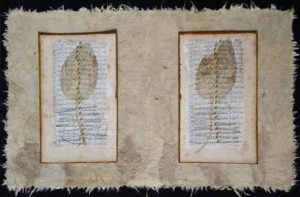 A.G.: In consequence, your range of techniques and materials is very large. After your graduation, you made mosaics, frescos, engravings and carpets. Natural materials like leafs and tree bark are as well elements like book pages, handmade paper and canvas. Is it possible to distinguish your oeuvre in different periods, where you worked primarily with one particular technique? Are there continuities?
A.G.: In consequence, your range of techniques and materials is very large. After your graduation, you made mosaics, frescos, engravings and carpets. Natural materials like leafs and tree bark are as well elements like book pages, handmade paper and canvas. Is it possible to distinguish your oeuvre in different periods, where you worked primarily with one particular technique? Are there continuities?
G.S.: As I said, all the techniques attracted me. Everything of my environment is valuable to be included into my work. Experimentation is for me the most exciting thing of all. Every material teaches something. This concerned me a lot.
After the academy price, I was in contact with several architects. I’ve done a wall tempera at the Hotel Hübner in Schönbrunn/Vienna, a fresco Villach, carpets for Georg Kovacs in New York. With my friend, I’ve made enamel, which was very fascinating. Later I combined this technique on the pebbles of the Danube.
There are other continuities. For example: yet during my studies at the academy, I’d made drawings with china ink on fabric. So I knew that it is possible to do it and how to do it. Years later, I’ve written on fabric, for example on a bed sheet.
I think, that it’s difficult to distinguish periods because they are all interrelated. The most important continuity is the research. In the execution, there is less steadiness, since I use many different materials.
A.G.: When you met your husband, Dino Gavina, you followed him to Bologna, Italy. During seven years, you paused your artistic activities to take care of your children. Was this a turning point in your artistic work? Did your oeuvre change afterwards?
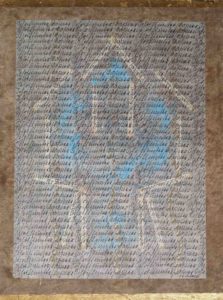 G.S.: (Thinks about it) No. Naturally, I didn’t have the support of a laboratory anymore. In Vienna, there was this ambience with my acquaintances. However, when I had my own studio here, I started to draw. Afterwards all my knowledge entered in my work. I’ve made handmade paper, painted picture frames and I used paper, canvas, fabric and stone. The results are often smaller pieces, like artist books, but as well large paintings.
G.S.: (Thinks about it) No. Naturally, I didn’t have the support of a laboratory anymore. In Vienna, there was this ambience with my acquaintances. However, when I had my own studio here, I started to draw. Afterwards all my knowledge entered in my work. I’ve made handmade paper, painted picture frames and I used paper, canvas, fabric and stone. The results are often smaller pieces, like artist books, but as well large paintings.
A.G.: Due to his work as entrepreneur, your husband frequented many creatives like Carlo Scarpa and Lucio Fontana. To what extent did this influence your work?
G.S.: It was primarily mentally, in the daily life. In our work, we had each our own studio. He had his occupation and I had mine. Each of us worked independently of the other.
A.G.: You are working often with scripture, particularly with the Austrian Kurrent script. Which role does it play for you?
G.S.: Books and writings have always attracted me. This was born in my childhood, when my father allowed me to intervene in books. I was permitted to draw at the white pages at the beginnings and ends of the books. This gave me perhaps a force, a security.
I’m using the Kurrent script, because it was the first handwriting that I learned. This must have had an impact on me. Nevertheless, the scripture doesn’t have to express anything in my work. It is only a module to have these spotlights, which express the true essence for me.
“Light can have a contact with you”
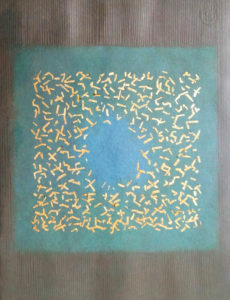 A.G.: Gold leaf is very common in your works. When do you use it and which significance does it have for you?
A.G.: Gold leaf is very common in your works. When do you use it and which significance does it have for you?
G.S.: Gold has various roles. First, there is the Austrian context with Klimt and the Secession. This has influenced me, since I have lived in this ambiance.
Furthermore, I like gold, because for me it is light, with its ambiguity: depending on the viewpoint it is shining, or is only golden yellow. I like this as an essence. Light can have a contact with you: when it is shining, there is a reflex. From another viewpoint, there is no reflex. The reflex is very important for me, because these highlights give a vibrational information. And when this information finds a resonance in the spectator, the spectator discovers something behind: he/she feels the vibration. This is every thought, which has a personal music, a code or information, whatever you might call it. When someone else feels something, it means, there is a resonance. For that reason, one likes an artwork or not, depending if someone finds something or not.
I do not believe that a painting has to talk to everybody, neither tell to everyone the same thing. It is only for these people who find a resonance, a vibrational similarity.
A.G.: The dimensions of your works are as variable as the used materials and the techniques. They might be in postcard-format but also up to three-meter canvases. Which advantages have the different formats?
G.S.: The format always depends on the circumstances of the creation.
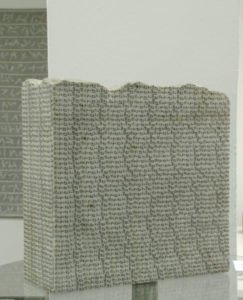 A.G.: Already at the beginning of your career, you had an international audience. Your carpets had been on view and sold in New York. Moreover, you exhibited continuously during the last 65 years. Nevertheless, in the last decades, your solo exhibitions and group participations were limited geographically mainly in Italy and Austria. The Richard Saltoun Gallery in London renders your works again accessible to a larger international public. How does this feel?
A.G.: Already at the beginning of your career, you had an international audience. Your carpets had been on view and sold in New York. Moreover, you exhibited continuously during the last 65 years. Nevertheless, in the last decades, your solo exhibitions and group participations were limited geographically mainly in Italy and Austria. The Richard Saltoun Gallery in London renders your works again accessible to a larger international public. How does this feel?
G.S.: I have always exhibited, because I needed to maintain myself. It was as well useful. Nevertheless, one doesn’t become an artist in one day. Perhaps it is the mirror of a whole life. This is as well very nice.
Due to this, it is only consequently, that Richard Saltoun discovered me lately. Besides, he made my acquaintance via Li Yuan-Chia, with whom I worked for a while. Fortunately, at the end of my life I’ve met the right gallerist. I’m happy! Even when I’m not there anymore, my work will continue to be presented with Richard Saltoun.
Nevertheless, all my experiences left traces, which still enter into my work. While I’m writing, I’m living, I’m thinking, I’m existing.
A.G.: Dear Greta, I hope you will continue to create for a long time. Thank you for this interview.
Read more: http://gretaschoedl.altervista.org
